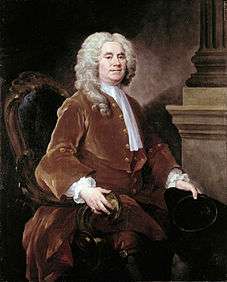William Jones (mathematician)
| William Jones | |
|---|---|
 Portrait of William Jones by William Hogarth, 1740 (National Portrait Gallery) | |
| Born |
1675 Llanfihangel Tre'r Beirdd, Isle of Anglesey |
| Died |
3 July 1749 London, England |
| Part of a series of articles on the |
| mathematical constant π |
|---|
 |
| Uses |
| Properties |
| Value |
| People |
| History |
| In culture |
| Related topics |
William Jones, FRS (1675 – 3 July 1749) was a Welsh mathematician, most noted for his proposal for the use of the symbol π (the Greek letter pi) to represent the ratio of the circumference of a circle to its diameter. He was a close friend of Sir Isaac Newton and Sir Edmund Halley. In November, 1711 he became a Fellow of the Royal Society, and was later its Vice-President.[1]
Biography
William Jones was born the son of Siôn Siôr (John George Jones) and Elizabeth Rowland in the parish of Llanfihangel Tre'r Beirdd, about 4 miles west of Benllech on the Isle of Anglesey. He attended a charity school at Llanfechell, also on the Isle of Anglesey, where his mathematical talents were spotted by the local landowner who arranged for him to be given a job in London working in a merchant's counting-house. He owed his successful career partly to the patronage of the distinguished Bulkeley family of north Wales, and later to the Earl of Macclesfield.
Jones initially served at sea, teaching mathematics on board Navy ships between 1695 and 1702, where he became very interested in navigation and published A New Compendium of the Whole Art of Navigation in 1702,[2] dedicated to a benefactor John Harris.[3] In this work he applied mathematics to navigation, studying methods of calculating position at sea. After his voyages were over he became a mathematics teacher in London, both in coffee houses and as a private tutor to the son of the future Earl of Macclesfield and also the future Baron Hardwicke. He also held a number of undemanding posts in government offices with the help of his former pupils.
Jones published Synopsis Palmariorum Matheseos in 1706, a work which was intended for beginners and which included theorems on differential calculus and infinite series. This used π as an abbreviation for perimeter. His 1711 work Analysis per quantitatum series, fluxiones ac differentias introduced the dot notation for differentiation in calculus.[4] In 1731 he published Discourses of the Natural Philosophy of the Elements.
He married twice, firstly the widow of his counting-house employer, whose property he inherited on her death, and secondly, in 1731, Mary, the 22-year-old daughter of cabinet-maker George Nix, with whom he had two surviving children. His son, also named William Jones and born in 1746, was a renowned philologist who established links between Latin, Greek and Sanskrit, leading to the concept of the Indo-European language group.[5]
References
- ↑ "Library and Archive catalogue". Royal Society. Retrieved 1 November 2010.
- ↑ "Jones biography". University of St. Andrews. Retrieved 12 December 2010.
- ↑ William Jones (1702). A New Compendium of the Whole Art of Navigation. Retrieved 2011-02-03.
- ↑ Garland Hampton Cannon (1990). The life and mind Oriental Jones. Retrieved 2011-02-03.
- ↑ Roberts, Gareth Ffowc (14 March 2015). "Pi Day 2015: meet the man who invented π". The Guardian. Retrieved 14 March 2015.
External links
- William Jones and other important Welsh mathematicians
- William Jones and his Circle: The Man who invented Pi
- Pi Day 2015: meet the man who invented π